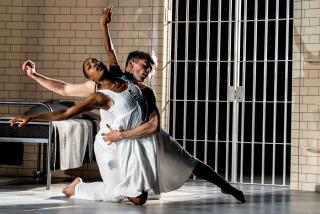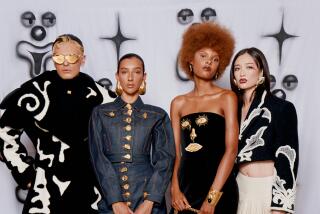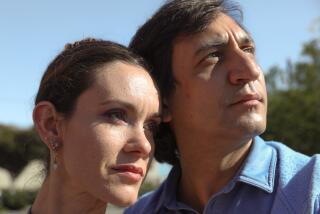L.A. Ballet delivers a classically pure ‘Sleeping Beauty’
Dancing through its first nine seasons, Los Angeles Ballet has bravely tackled one rite of passage after another — not merely the major Balanchine and Bournonville choreographies that are its stylistic birthright but, increasingly, the top-of-the-list, full-length 19th century classics that can leave dancers in any company cruelly exposed.
The latest example: a three-hour “Sleeping Beauty” Sunday afternoon in Royce Hall at UCLA that justified company (and civic) pride both as an index of growth and for sustained achievement. The Royce performance was the final of five performances over the last five weeks.
With its tiny morsels of plot and cornucopia of formal dances, “Sleeping Beauty” is a daunting challenge that Marius Petipa, the original choreographer, intended not as a typical Romantic story-ballet but an evocation of a much older theatrical dance tradition.
Shared purity of style is essential here, and long before the nominal leading dancers made their first entrances on Sunday, the women who performed short blessing-solos in the first half-hour of the ballet delivered the vibrant yet uninsistent classicism that co-directors Thordal Christensen and Colleen Neary have made into a company signature.
What’s more, Christensen and Neary boast backgrounds with the Royal Danish Ballet — long the acknowledged masters of 19th century ballet sign-language — so the vital mime conversations in “Sleeping Beauty” that can look clumsy or even ridiculous when other companies attempt them became utterly natural on Sunday. You try telling people, without speaking, that a baby is going to grow up, be beautiful, dance nicely yet prick her finger on a spindle and die. A lot easier to text it.
You might argue that the last act of this version suffers from extensive cuts that leave only classical showpieces, omitting the character and comic specialties that Petipa included for variety. And you might also note that the company’s skimpy male roster definitely needs the guests that have been popping up here and there.
A month earlier, at the Valley Performing Arts Center, Luke Schaufuss (son of ballet superstar Peter Schaufuss) danced a raw but powerful Bluebird in the production. And on Sunday, the role of King Florestan gained authority from the great dancing-actor of New York City Ballet, Adam Lüders.
Of course, a young company that dances to recorded music in borrowed sets has more to worry about than guests, and, indeed, there were times on Sunday when the slow, canned Tchaikovsky and the cramped Royce Hall stage took their toll. For example, in Act 1 alone the Garland Waltz needed more musical oomph, and Aurora’s solo after the Rose Adagio needed more space in front of the scenery.
But that’s about all Julia Cinquemani needed as Aurora. Gifted with a technique that made every high extension seem a major event, she had the unerring balances for the Rose Adagio, the dreamy inaccessibility for the Vision Scene and the radiant star power for the Grand Pas de Deux, all presented with a devastating freshness, as if she might be discovering the role as she danced it.
Allyssa Bross displayed many of these same qualities as Aurora on Feb. 28 at the Valley Performing Arts Center, and she ably transferred them to the role of the Lilac Fairy on Sunday, standing up to Neary’s furious Carabosse with dramatic flair. Neary’s special achievement was letting you see how genuinely injured this character felt — deep human emotion clashing with the stylized sweetness surrounding her.
Among the men, pride of place incontestably belonged to Kenta Shimizu, the one and only Prince Desire in every company performance. Admittedly he couldn’t do much with his dull, inexpressive I’m-so-lonely choreography in Act 2. But the mime, partnering and sense of urgency in the Vision Scene proved exemplary, and his elegance in the Grand Pas de Deux ideally complemented his Auroras, whether Cinquemani or Bross. Allynne Noelle wasn’t in the cast on Sunday, but at VPAC last month her Lilac Fairy had regal eloquence, and she also danced Aurora during the five-week run.
Dustin True made a diligent, low-flying Bluebird opposite Bianca Bulle, who soloed impressively both here and in the first fairy variation of the Prologue. The other fairies and/or jewels included Ashley Millar, Madison McDonough, Chloé Sherman, Elizabeth Claire Walker and Kate Highstrete. Without them, the staging would have lacked credibility as a whole.
A “Swan Lake” can thrill you with just a great Prince and Swan Queen, but “Sleeping Beauty” needs classical multitudes — especially sparkling women soloists. Heading toward its 10th season in September, Los Angeles Ballet clearly has them, and they may be sorely tested by the anti-classical modern dance and crossover repertory on their agenda this summer. For a company as ambitious as this one, the rites of passage never stop — and neither does the excitement.
David Walker’s scenery for a Boston Ballet production looked ideally sumptuous on the wide stage of Valley Performing Arts Center, but whatever could be accommodated at Royce Hall framed the dancers richly.
More to Read
The biggest entertainment stories
Get our big stories about Hollywood, film, television, music, arts, culture and more right in your inbox as soon as they publish.
You may occasionally receive promotional content from the Los Angeles Times.






